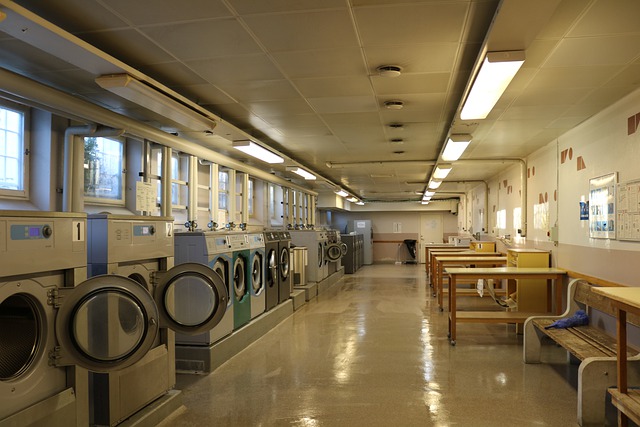Laundry Room Flooring (Best Types & Options)

When it comes to choosing the right type of flooring for your laundry room, you need to make sure you are picking out something that will hold up to the elements throughout the years. The type of flooring you choose for your laundry room will ultimately decide how your laundry room looks, how it will hold up, and how much money you spend on it to replace it in the future.
There are two basic types of flooring you can choose for your laundry room – vinyl and hardwood – and they have very different pros and cons for this room. In this post, we’ll discuss vinyl vs. hardwood as well as the options you have for each.
Laundry rooms are one of the most used rooms in the home, whether it is to wash clothes or to do other things. They can be pretty small in size, even in larger homes, but there are some basic things that can be done to make them more efficient.
Here’s our guide to laundry room flooring including the popular types of flooring such as vinyl, tile, concrete, laminate and engineered wood for your laundry room design. 
Laundry Room Flooring Options
Here are some of the most popular laundry room flooring options.
Laundry Room Vinyl Flooring
Sheet vinyl and luxury vinyl are the two kinds of vinyl flooring available. Let’s begin with the first.

Sheet vinyl flooring is a great option if you want a single sheet material that is completely moisture-proof for your laundry room. However, measurements are restricted since it cannot function effectively in laundry rooms with a lot of area.
Sheet vinyl flooring is only suitable for laundry rooms with a width of 12 feet or less, since it comes in 12 foot rolls. It’s ideal if you pair it with a thermoplastic rubber wall foundation to get the most out of it. It doesn’t have any seams and is completely waterproof.
The main disadvantages are that it does not add much to the aesthetics of the room because of its basic look, and it may be difficult or even impossible to install in big laundry rooms.
2. High-End Vinyl Flooring
Planks of 48 inches in length are used to make this material. Surprisingly, they may seem to be genuine wood from a distance, which is part of their attraction. It has a 7mm thickness and a strong and robust core.
It’s even fair to argue it looks more like laminate flooring than real vinyl. If you want to do your laundry room flooring yourself, these planks are ideal. To keep it watertight, you simply need to pay additional care to seaming the boards firmly on all sides.
It is completely waterproof, making it ideal for use in the laundry room. It’s also reasonably priced, so if you’re renovating on a budget, this is the ideal option. It’s also simple to put together, since you’ll just need high-quality adhesives or rubber cement.
The main disadvantages of luxury vinyl flooring are that it is a seamed material, which means water may still seep through, and its core is hard, which means it can break or fracture. Here’s more on the benefits and drawbacks of vinyl flooring in bathrooms.
Tile is a kind of flooring.

Granted, the tiles may be difficult to walk on at times, particularly during the winter, but this is readily rectified with radiant heating. Tiles come in a variety of sizes and designs, so your only restriction is your imagination.
They’re simple to clean and won’t be harmed if you scrub them vigorously, so they’re ideal for any spills or stains in the laundry room. The main disadvantage of tiles is that they need expert installation since they require strong substrates and amateur applications may result in water leaks and uneven surfaces.
Flooring made of concrete

You can certainly soften the appearance by laying on a large rug to provide a little bit of warmth for your feet. Concrete flooring is long-lasting and, in terms of maintenance, it’s simple to clean and, by default, waterproof. However, it may be extremely chilly on the feet and unsightly without add-ons.
Flooring made of laminate

Although it may be utilized in the laundry room, it’s important to keep in mind that this kind of flooring is susceptible to damage during floods or periods when pools of water remain on the floor.
If you want to use this as your laundry room flooring, be sure you seam it firmly and put an additional pan under the washing machine as a catch-basin. One disadvantage to be aware of is that laminates may delaminate with time, necessitating replacement every now and again.
Engineered Wood Flooring is a kind of engineered wood flooring that is made

The main drawback is that it may be very costly, and it can delaminate over time if exposed to water and laundry detergents.
The Best Laundry Room Flooring
Sheet vinyl flooring is often regarded the finest flooring for a laundry room owing to its waterproof nature, low cost, and longevity. However, there is no such thing as a “best” choice for laundry room flooring since it will ultimately rely on your budget, goals, and tastes.

Tile choices, concrete flooring, and, on the lower end, vinyl sheet flooring are some of the hardest flooring materials listed above that are very resistant to water leakage. More information about different kinds of flooring for interior design may be found here.
You may go with somewhat more costly flooring choices that have aesthetic value but need continuous care, or you could go with less expensive options that are more likely to leak and require more maintenance.
Again, as previously said, it’s critical to consider the factors that are most important to you, whether it’s your money, convenience, or even aesthetics. After that, you’ll be able to simply choose the material you want for your laundry room flooring.
Visit our laundry room paint colors page for additional options.
Frequently Asked Questions
Whats the best type of floor for a laundry room?
The best type of floor for a laundry room is one that is easy to clean and maintain. A concrete floor would be the best option, as it is durable and can easily be cleaned with a mop or broom.
What is used as laundry flooring?
Laundry flooring is a type of floor covering made from a durable material, usually vinyl or rubber. It is used primarily in commercial laundries and industrial settings.
Can you put luxury vinyl in a laundry room?
Yes.
Related Tags
This article broadly covered the following related topics:
- vinyl flooring for laundry room
- laundry room flooring trends
- best flooring for laundry room
- best laundry room flooring
- flooring for laundry room with floor drain

 The Importance of Choosing the Perfect Mattress for a Good Night’s Sleep
The Importance of Choosing the Perfect Mattress for a Good Night’s Sleep  Tailored Tranquility: Exploring Custom Backyard Designs
Tailored Tranquility: Exploring Custom Backyard Designs  House Hunting: Finding Homes for Sale in Knightdale, NC
House Hunting: Finding Homes for Sale in Knightdale, NC